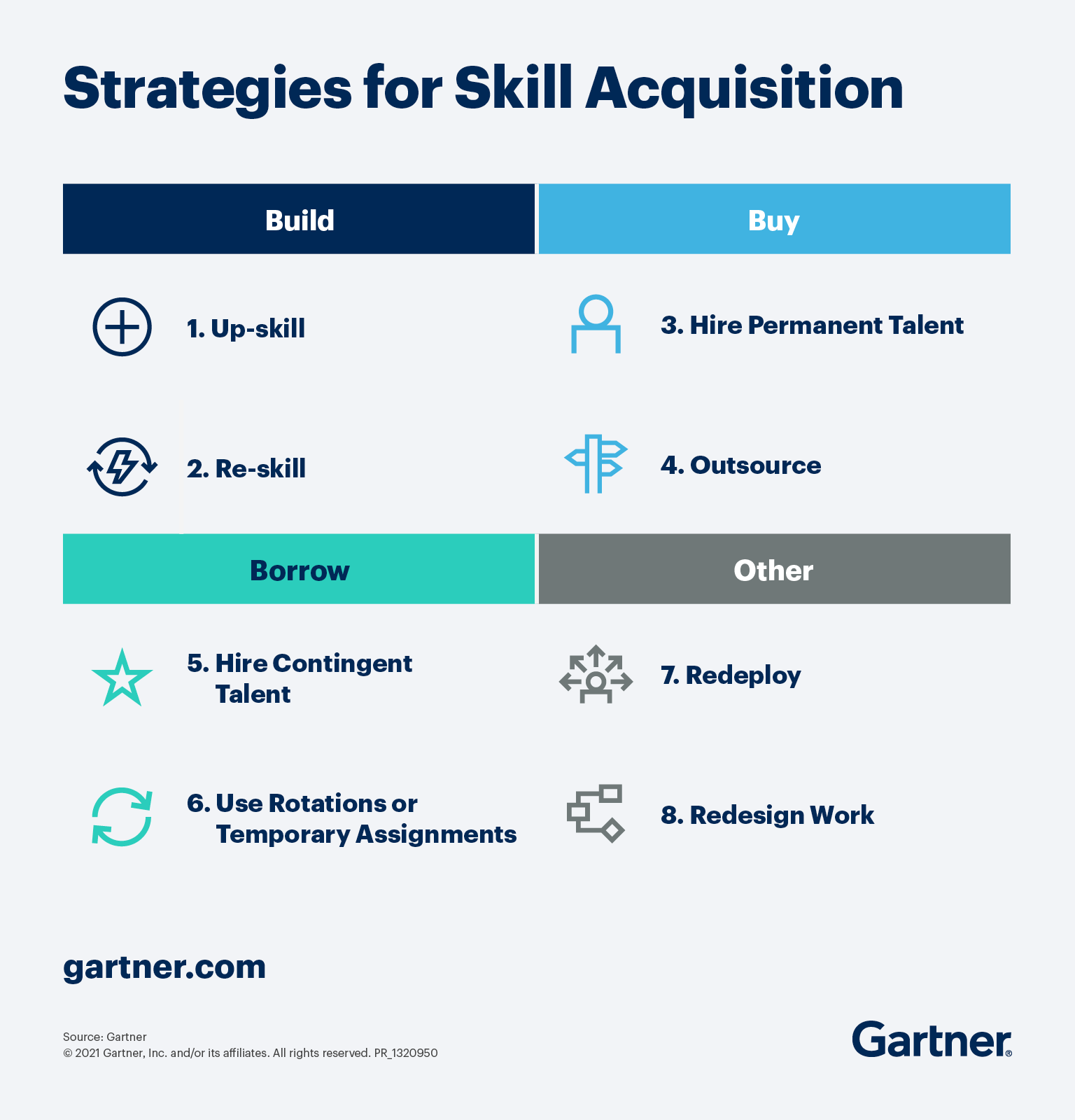June 08, 2021
- Gartner client? Log in for personalized search results.
4 HR Talent Strategies for the Postpandemic Labour Market
Contributor: Teresa Zuech
To fill short- and long-term critical skills needs, HR leaders can look beyond simple frameworks and select the best-fit mix from these four talent strategies.
Explore the latest: Top 5 HR Trends and Priorities for 2022
According to the 2020 Gartner View From the Board of Directors Survey, digital tech initiatives are the No. 1 priority of board members — and organisations feel the urgency. However, a lack of niche digital skills coupled with high demand threatens innovation and long-term competitive advantages while also driving up hiring costs.
Hiring permanent talent with critical skills is already both expensive and difficult, and as a result, HR executives and their teams are already starting to look into other options.
19%
The 2019 Gartner Hiring Manager Panel Survey revealed that 80% of hiring managers were open to considering alternatives for their most recent hire, but only 19% of hiring managers reported that their recruiter or HR business partner prompted them to consider alternative work models.
“To fill skills needs in this competitive landscape, HR leaders will need to use every tool available to them,” says Ryan Hill, Director, Advisory, Gartner. “But selecting the right talent strategies for long-term and immediate needs can be a serious challenge for many organisations.”
Learn more: Who Is Winning the Talent War Postpandemic?
Companies that build flexibility in their talent strategies will have a competitive advantage over those that do not. Prior to deciding which hiring strategy will be most effective or what critical skills to hire, HR leaders should first consider:
- Costs: The direct financial or nonfinancial costs of the talent strategy. This can be both short- and long-term costs.
- Time: The time required to effectively implement the strategy for the needed skills acquisition.
- Long-term value: The benefit of implementing the strategy beyond the immediate needs of the project. For example, will a certain skill enable more innovation or cost savings?
- Viability: Internal and external prerequisites for implementing the strategy. This refers to, for example, the capability of HR, L&D, recruiting or other functions to implement their part of the strategy.
- Impact: What effect will adopting the talent strategy have on the existing workforce? For example, could it increase employee satisfaction or be harmful to employee engagement?
To fill skills needs both effectively and efficiently, HR leaders should consider these four categories when choosing their talent strategies:
No. 1: Build
Upskilling is a strategy that enhances existing or adjacent skills. Adjacent skills are skills closely related to a critical skill and typically appear alongside it in employee skills profiles.
For example, Gartner TalentNeuron™ data shows that cloud developers skilled in AWS have relevant skill adjacencies for other software such as Microsoft Azure, Frameworks or Jenkins. By analyzing adjacent skills, organisations can more easily upskill employees and open up possibilities to build internal capabilities more quickly.
Additionally, reskilling develops new skills to pivot from an expiring skill set toward an in-demand one. Reskilling instills a culture of learning within an organisation and makes it easier to address future skill gaps by creating a robust internal labor market.
No. 2: Buy
Hiring individuals and outsourcing are two alternatives for HR leaders looking to invest in talent.
Acquiring skills by hiring individuals — whether full- or part-time, internal or external to the organisation — guarantees access to target skills. In addition, hired individuals have the opportunity to upskill over time.
On the other hand, while outsourcing can be timely due to vendor selection and management, it provides savings due to potential cost optimisations. Also, outsourcing facilitates addressing urgent skills needs while providing a clear scope of work to the vendor. However, HR leaders should be aware that outsourcing presents difficulties like decreased engagement and performance from employees working alongside vendors.
No. 3: Borrow
Hiring contingent talent and using rotational assignments gives HR leaders the opportunity to find potential candidates and tap into the gig economy.
Contingent talent enables HR leaders to acquire skills for a defined period of time. A contingent worker, for example, might have multiple assignments and work with one or multiple organisations at the same time. More importantly, contingent workers offer a fresh set of eyes and a unique perspective to an organisation.
From a cost perspective, organisations pursuing contingent workers would save on factors such as compensation, benefits, recruiting and training.
Leading organisations also adopt rotational or temporary assignments for existing employees. This gives employees exposure to new skills, roles and teams in a timely manner. One of the long-term benefits of this approach is the strengthened partnership between different parts of the organisation, as well as the knowledge transfer that occurs with this model.
No. 4: Redeploy and Redesign
Two additional alternatives are redeploying employees and redesigning work.
Redeploying entails moving existing employees with needed skills permanently to new roles or teams. For example, an employee can be transferred from a discontinued business unit to a new business unit. This strategy, however, can have downsides for both organisations and individuals. From an organisational perspective, organisations might have to incur the costs of relocation or releveling. Additionally, redeployment could result in unintended psychological impact for employees.
Addressing these risks related to the redeployment process strengthens retention of institutional knowledge and gives employers the ability to promote how they invest in their workforce.
Lastly, redesigning work enables employees to more effectively perform required skills through readjustments of workflows, designs and networks. This yields long-term benefits such as increased efficiency of entire organisational designs and a potential increase in productivity and engagement if the redesign is successful.
Recommended resources for Gartner clients*:
Deciding on Your Talent Strategies: Build, Buy, Borrow, Rent and More
Tool: Framework for Making the Build, Buy, Borrow, (and Other) Decision
Leverage Role Adjacencies to Respond to the Shifting Talent Market Amid Disruption
*Note that some documents may not be available to all Gartner clients.

